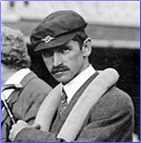Inductee Profile
Glenn H. Curtiss
 The American aviation pioneer Glenn Hammond Curtiss (1878-1930) developed the first successful seaplane and manufactured the famous World War I Jenny training plane.
The American aviation pioneer Glenn Hammond Curtiss (1878-1930) developed the first successful seaplane and manufactured the famous World War I Jenny training plane.
Glenn Curtiss was born in Hammondsport, N.Y. After finishing grade school, he moved to Rochester, working for the telegraph company and later for the Kodak Company. However, having acquired a taste for mechanics and a passion for speed, he returned to Hammondsport and opened a bicycle shop. He raced bicycles and won many prizes locally and statewide. When motorcycles became available, he began to race them as well, and in 1902 he started to make and sell first the motors, then the entire motorcycles, at his shop. He became famous as a racer and in 1906, riding an eight-cylinder cycle of his own construction, set a speed record of 137 miles per hour, which stood for 20 years.
After the dirigible balloonist Thomas Scott Baldwin ordered an engine for one of his balloons from Curtiss, Curtiss concentrated on the problems of flight. A balloon powered by a Curtiss engine won a major race at the St. Louis International Exposition in 1904. Baldwin moved to Hammondsport, and the two men manufactured the first dirigible adopted by the U.S. Army.
The successful flight of the Wright brothers in 1903 had demonstrated the potential of heavier-than-air craft, and Curtiss now turned in this direction. Alexander Graham Bell, the inventor of the telephone, for some years had been an enthusiastic supporter of airplane development, and in 1907 established the Aerial Experiment Association at Hammondsport, placing Curtiss in charge of experiments. A year later Curtiss won the Scientific American trophy flying his famous June Bug. During the next several years he won many air races in the United States and abroad. In 1908 Curtiss began to work on the problems of seaplanes and three years later successfully took off from, and landed again on, the water off San Diego, California. In 1912 he developed his famous flying boat; and in 1919 his NC4, developed for the U.S. Navy, became the first airplane to cross the Atlantic Ocean.
After the outbreak of World War I, Curtiss moved his manufacturing facilities to Buffalo and built, by 1919, more than 5,000 Jennies. After the war Curtiss worked on automobiles and other devices as well as airplanes and was active in the Curtiss-Wright Corporation.
Glenn Curtiss name legacy on Long Island continues through Curtiss-Wright Flow Control ("CWFC") in Farmingdale. CWFC, the flow control segment of Curtiss-Wright Corporation, was founded in 1950 and specializes in the design and manufacture of highly engineered valves, pumps, electronics and related products for naval propulsion systems. Today, CWFC's sophisticated products are installed on every nuclear submarine and aircraft carrier commissioned by the United States Navy and an integral part of worldwide commercial nuclear power plants, oil and gas processing facilities, automotive and general industrial markets.